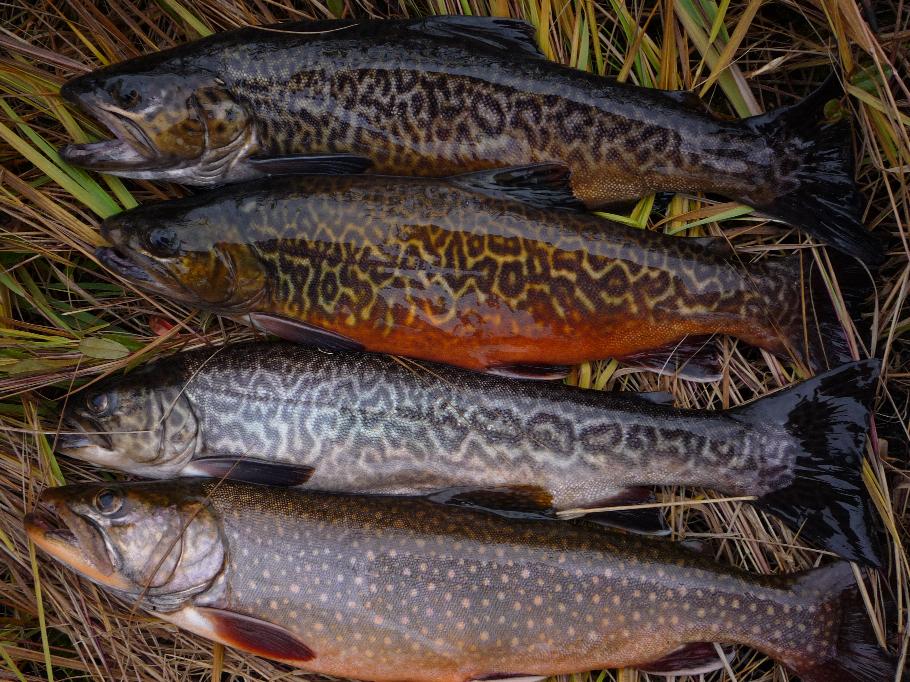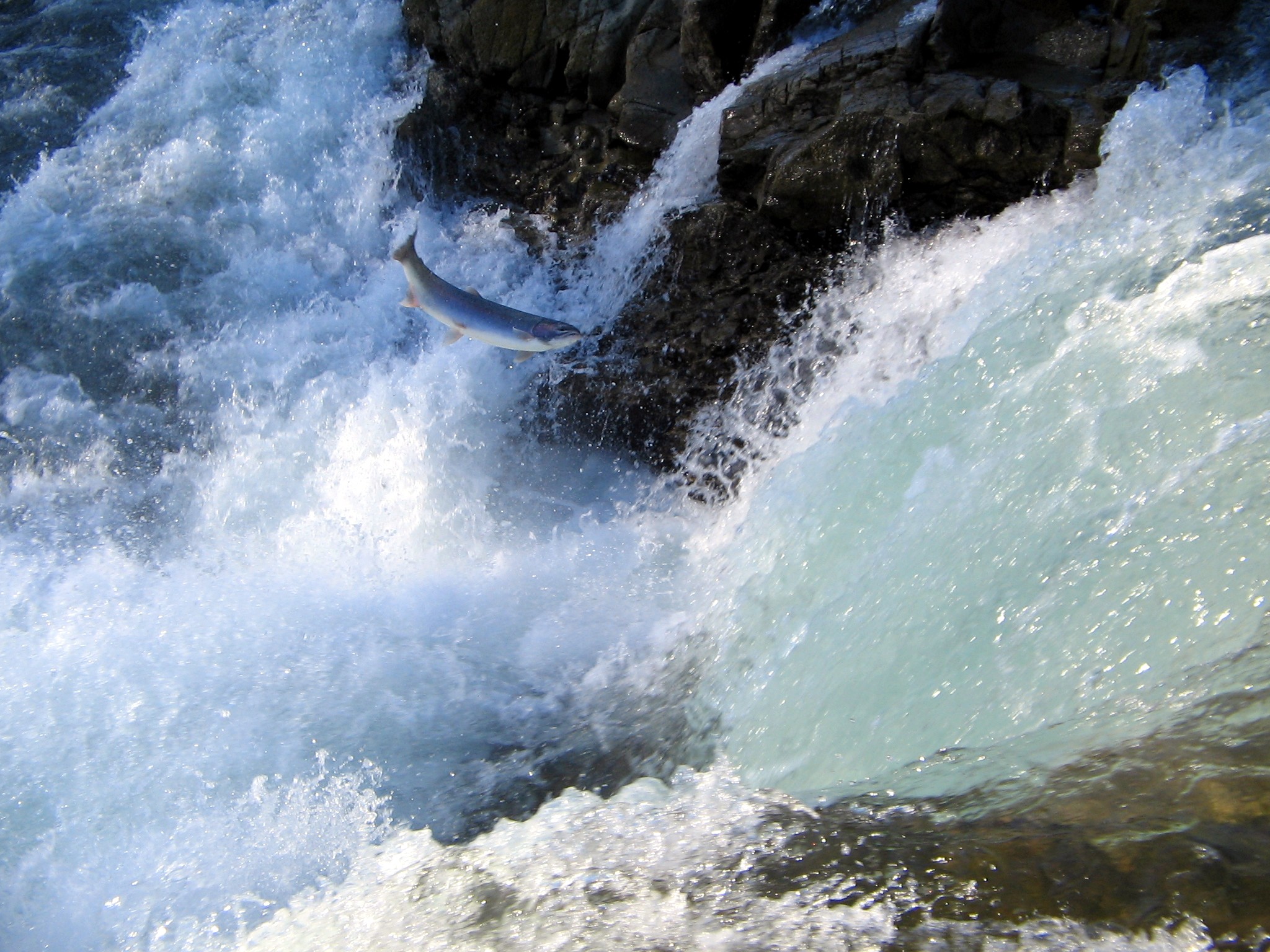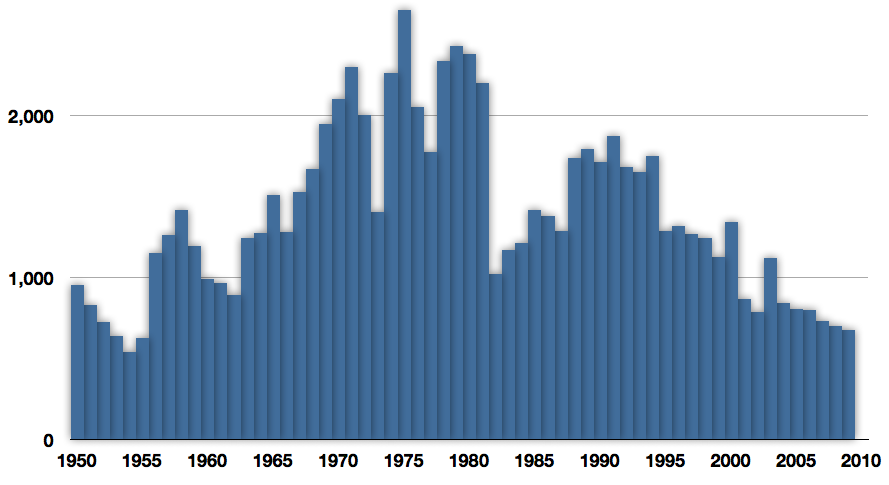|
Saint-Paul River
The Saint-Paul River (, ) is a river on the Labrador Peninsula of eastern Canada. Its source is located in the province of Newfoundland and Labrador and it empties into the Gulf of Saint Lawrence in the Côte-Nord region of Quebec. The Saint-Paul River is a salmon river that flows in a southerly direction. Location The river rises on the height of land between the Atlantic and Saint Lawrence. The main channel is about , of which about is in Labrador. The river has a Strahler number of 7. It flows in a southerly direction, and empties into Esquimaux Bay in the Vieux Fort archipelago, about west of the municipality of Blanc-Sablon. The last fifteen kilometers of its course define the boundary between the cantons of Chevalier and Bonne-Esperance. The mouth of the river is in the municipality of Bonne-Espérance in Le Golfe-du-Saint-Laurent Regional County Municipality. The village of Rivière-Saint-Paul is located on the west side of its mouth. Name The Inuit who once lived at ... [...More Info...] [...Related Items...] OR: [Wikipedia] [Google] [Baidu] |
Côte-Nord
Côte-Nord (Region 09) (, ; ) is an List of regions of Quebec, administrative region of Quebec, on the Quebec-Labrador peninsula, Quebec-Labrador Peninsula, Canada. The region runs along the St. Lawrence River and then the Gulf of St. Lawrence, from Tadoussac to the limits of Labrador, leaning against the Saguenay–Lac-Saint-Jean to the west, the Côte-Nord penetrates deep into Nord-du-Québec, Northern Quebec. With the motto: ''Between nature and grandeur'', the Côte-Nord is made up of 99% public land, it is the second largest region after Nord-du-Québec, which occupies 51% of Quebec's territory. History The origins of the settlement of the Côte-Nord precede by a few millennia the population movements that began in the middle of the 19th century. Archaeology, Archaeologists tell us that the main prehistoric cultures, called "Archaic humans, archaic", were based on three sets of groups coming from the southwest, from as far away as the Great Lakes by the St. Lawrence Rive ... [...More Info...] [...Related Items...] OR: [Wikipedia] [Google] [Baidu] |
Petit-Mécatina, Quebec
Petit-Mécatina () is an unorganized territory (Quebec), unorganized territory in the Côte-Nord region of Quebec, Canada, part of Le Golfe-du-Saint-Laurent Regional County Municipality. It was formerly part of the Minganie Regional County Municipality, but transferred to the current MRC in July 2010. It is named after the Petit Mécatina River that bisects the territory from north to south and empties in the Gulf of Saint Lawrence just west of Petit Mécatina Island. The river forms east of Lake Aticonac just south of the boundary between the Atlantic and Saint Lawrence watersheds, that is also the Labrador#Boundary dispute, disputed boundary between Quebec and Labrador. Mécatina comes from the Innu language, Innu word ''makatinau'' and means "large mountain". As part of the Labrador boundary dispute, the official borders of Petit-Mécatina as claimed by Quebec include part of the territory of Labrador. Demographics The region has been completely uninhabited since at least 19 ... [...More Info...] [...Related Items...] OR: [Wikipedia] [Google] [Baidu] |
Commission De Toponymie Du Québec
The Commission de toponymie du Québec (, ''Toponymy Commission of Québec'') is the Government of Québec's public body responsible for cataloging, preserving, making official and publicizing Québec's place names and their origins according to the province's toponymy rules. It also provides recommendations to the government with regard to toponymic changes. Its mandate covers the namings of: * natural geographical features (lakes, rivers, mountains, etc.) * constructed features (dams, embankments, bridges, etc.) * administrative units (wildlife sanctuaries, administrative regions, parks, etc.) * inhabited areas (villages, towns, Indigenous peoples in Canada, Indian reserves, etc.) * roadways (streets, roads, boulevards, etc.) A child agency of the Office québécois de la langue française, it was created in 1977 through jurisdiction defined in the Charter of the French Language to replace the Commission of Geography, created in 1912. See also * Toponymy * Toponym'elles * Offi ... [...More Info...] [...Related Items...] OR: [Wikipedia] [Google] [Baidu] |
Matapédia River
The Matapedia River (, ) is a river in the Matapedia Valley in the province of Quebec, Canada. It runs on from Matapedia Lake down to the village of Matapédia where it empties into the left bank of Restigouche River on the provincial border of New Brunswick. This freshwater course forms a natural border between the administrative regions of Bas-Saint-Laurent and Gaspésie-Îles-de-la-Madeleine. The river is a North South divide in the Notre Dame Mountains that characterize the relief of the Gaspé Peninsula. The Matapedia River basin drains an area of about . Matapedia River is often called the'' Salmon Capital ''. From the South side of Matapedia Lake and going to the South, the route 132 along the river goes on its entire length by the East bank. The Canadian National Railway passes South of Matapedia Lake continues on the West bank of the river in Causapscal where the bridge at South of the village made the railway cross on the East bank. The track then cont ... [...More Info...] [...Related Items...] OR: [Wikipedia] [Google] [Baidu] |
Gros Mécatina River
The Gros Mécatina River () is a salmon river in the Côte-Nord region of Quebec, Canada. It empties into the Gulf of Saint Lawrence. Location The Gros Mécatina River is about long, and originates in Lac Boucher east of the Little Mecatina River and north-west of Robertson Lake. It has a winding course and passes through many lakes. The river flows in a generally southeast direction and empties into the Gulf of St. Lawrence near the Gros Mécatina Archipelago, west of the Baie des Moutons and the village of Mutton Bay. The hills just inland from Mutton Bay are almost high. The mouth of the Gros Mécatina River is in the municipality of Gros-Mécatina, Quebec, Gros-Mécatina in Le Golfe-du-Saint-Laurent Regional County Municipality. The Gros Mécatina Archipelago is in the Gulf to the southeast of the point at the river's mouth. The river basin includes parts of the unorganized territory Petit-Mécatina, Quebec, Petit-Mécatina and the municipalities of Côte-Nord-du-Golfe-du-S ... [...More Info...] [...Related Items...] OR: [Wikipedia] [Google] [Baidu] |
Rainbow Smelt
The rainbow smelt (''Osmerus mordax'') is a North American species of fish of the family (biology), family Osmeridae. Walleye, trout, and other larger fish prey on these smelt. The rainbow smelt prefer juvenile cisco (fish), ciscoes, zooplankton such as Calanoida, calanoid copepods (''Leptodiaptomus ashlandi'', ''Leptodiaptomus minutus, L. minutus'', ''Leptodiaptomus sicilis, L. sicilis''), and other small organisms, but are aggressive and will eat almost any fish they find. They are anadromous spring spawners and prefer clean streams with light flow and light siltation. The rainbow smelt face several barriers. They are weak swimmers and struggle to navigate fish ladders preventing them from making it past dams to the headwater streams where they spawn. The rise in erosion and dams helped to decimate the smelt population in the 1980s. There are currently plans to try to reduce damming and to help control erosion. Description The body of the rainbow smelt is slender and cylindric ... [...More Info...] [...Related Items...] OR: [Wikipedia] [Google] [Baidu] |
Brook Trout
The brook trout (''Salvelinus fontinalis'') is a species of freshwater fish in the char genus ''Salvelinus'' of the salmon family Salmonidae native to Eastern North America in the United States and Canada. Two ecological forms of brook trout have been recognized by the US Forest Service. One ecological form is long-lived potamodromous populations in Lake Superior known as coaster trout or coasters. The second ecological form is the short-living predaceous anadromous populations which are found in northern lakes and coastal rivers from Long Island to Hudson Bay, which are referred to as salters. In parts of its range, it is also known as the eastern brook trout, speckled trout, brook char (or charr), squaretail, brookie, or mud trout, among others. Adult coaster brook trout are capable of reaching sizes over 2'' ''feet in length and weigh up to 6.8'' ''kg (15'' ''lb), whereas adult salters average between 6 and 15'' ''inches in length and weigh between 0. ... [...More Info...] [...Related Items...] OR: [Wikipedia] [Google] [Baidu] |
Anadromous
Fish migration is mass relocation by fish from one area or body of water to another. Many types of fish migrate on a regular basis, on time scales ranging from daily to annually or longer, and over distances ranging from a few metres to thousands of kilometres. Such migrations are usually done for better feeding or to reproduce, but in other cases the reasons are unclear. Fish migrations involve movements of schools of fish on a scale and duration larger than those arising during normal daily activities. Some particular types of migration are ''anadromous'', in which adult fish live in the sea and migrate into fresh water to spawn; and ''catadromous'', in which adult fish live in fresh water and migrate into salt water to spawn. Marine forage fish often make large migrations between their spawning, feeding and nursery grounds. Their movements are associated with ocean currents and with the availability of food in different areas at different times of the year. The migratory ... [...More Info...] [...Related Items...] OR: [Wikipedia] [Google] [Baidu] |
American Eel
The American eel (''Anguilla rostrata'') is a facultative catadromous eel found on the eastern coast of North America. Anguillidae, Freshwater eels are fish belonging to the Elopomorpha, elopomorph superorder, a group of Phylogenetics, phylogenetically ancient teleosts. The American eel has a slender, supple, snake-like body that is covered with a mucus layer, which makes the eel appear to be naked and slimy despite the presence of minute Fish scale, scales. A long dorsal fin runs from the middle of the back and is continuous with a similar ventral fin. Pelvic fins are absent, and relatively small pectoral fin, pectoral fins can be found near the midline, followed by the head and gill covers. Variations exist in coloration, from olive green, brown shading to greenish-yellow and light gray or white on the belly. Eels from clear water are often lighter than those from dark, Blackwater river, tannic acid streams. The eel lives in fresh water and estuaries and only leaves these habi ... [...More Info...] [...Related Items...] OR: [Wikipedia] [Google] [Baidu] |
Atlantic Salmon
The Atlantic salmon (''Salmo salar'') is a species of ray-finned fish in the family Salmonidae. It is the third largest of the Salmonidae, behind Hucho taimen, Siberian taimen and Pacific Chinook salmon, growing up to a meter in length. Atlantic salmon are found in the northern Atlantic Ocean and in rivers that flow into it. Most populations are anadromous, hatching in streams and rivers but moving out to sea as they grow where they mature, after which the adults seasonally move upstream again to spawn. When the mature fish re-enter rivers to spawn, they change in colour and appearance. Some populations of this fish only migrate to large lakes, and are "landlocked", spending their entire lives in freshwater. Such populations are found throughout the range of the species. Unlike Pacific species of salmon, ''S. salar'' is iteroparous, which means it can survive spawning and return to sea to repeat the process again in another year with 5–10% returning to the sea to spawn again ... [...More Info...] [...Related Items...] OR: [Wikipedia] [Google] [Baidu] |
Basques
The Basques ( or ; ; ; ) are a Southwestern European ethnic group, characterised by the Basque language, a Basque culture, common culture and shared genetic ancestry to the ancient Vascones and Aquitanians. Basques are indigenous peoples, indigenous to, and primarily inhabit, an area traditionally known as the Basque Country (greater region), Basque Country ()—a region that is located around the western end of the Pyrenees on the coast of the Bay of Biscay and straddles parts of north-central Spain and south-western France. Etymology The English word ''Basque'' may be pronounced or and derives from the French ''Basque'' (), itself derived from Gascon language, Gascon ''Basco'' (pronounced ), cognate with Spanish ''Vasco ''(pronounced ). Those, in turn, come from Latin ''Vascō'' (pronounced ; plural ''Vascones, Vascōnēs''—see #History, history section below). The Latin generally betacism, evolved into the bilabials and in Gascon and Spanish, probably under the ... [...More Info...] [...Related Items...] OR: [Wikipedia] [Google] [Baidu] |
Ecological Regions Of Quebec
The Ecological regions of Quebec are regions with specific types of vegetation and climates as defined by the Quebec Ministry of Forests, Wildlife and Parks. Given the size of this huge province, there is wide variation from the temperate deciduous forests of the southwest to the arctic tundra of the extreme north. Vegetation zones Quebec covers more than of land between 45° and 62° north, with vegetation that varies greatly from south to north. Most of the natural vegetation is forest, with various species of trees and other plants, and these forests are the habitat for diverse fauna. Energy, precipitation and soil are all important factors in determining what can grow. The climate influences the natural disturbances that affect forests: western Quebec has a drier climate than the east, and experiences more fires. For most species these disturbances are not disasters, and some need them to regenerate. The climate in Quebec supports rich deciduous forest in the southern region ... [...More Info...] [...Related Items...] OR: [Wikipedia] [Google] [Baidu] |






